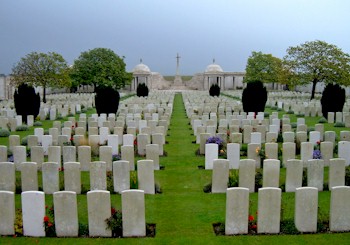|
|
| Home Topics Memorials Miscellany Transcripts References Family History Glossary Latest Beeston Blog About us | Site Search |
|
Harry Coulson, was born in Thurlby, Lincolnshire on 5 April 18982, the third son of Thomas & Mary Ann (née Brittain) Coulson. His father had worked originally as a farm labourer but, by 1901, he was keeping a public house on the High Street at Thurlby3. By 1911, the family had moved to Wollaton, Notts, where Thomas had taken a job as farm bailiff. By this time, there were five children still at home. Frederick, the second son, then 19, was working as a wagoner on a farm, Bessie (14), the second daughter was working as a cardboard box maker and Harry (15), Bessie (14), Jack(7) and Ena(4) were at school4. Their eldest son, Thomas (b.1890) had moved away and their eldest daughter, Emily Miriam (b. 1888), had married Herbert Arnold and was living in Wolverhampton. After leaving school, Harry started work at the Nottingham cigarette manufacturer, John Player & Sons as a box maker and continued there until his active service in the Army. On 18th May 1914, he volunteered for four years service with the Notts & Derby Territorial Force and was attached to 7th Battalion. By this time, he was living with his parents at 54 Regent Street, Beeston.5. As a member of the Territorial Force, Harry was mobilised within the first few days when War was declared on 4th August 1914, becoming part of 1/7th Battalion, one of two Battalions formed at Nottingham with men from the Territorial Force. The Battalion then moved to Harpenden, between Luton and St Albans in Hertfordshire, and then Braintree. There, they were inspected by King George V, a week before departing for France on 25th February 1915. The battalion moved into the Ypres salient and, in May of that year, became part of 139th Brigade/46th (North Midland) Division which took part in the fierce fighting at Hooge as part of the Second Battle of Ypres and its aftermath, during which ground was lost and then retaken by British troops6. In July, the enemy deployed flamethrowers - "liquid fire" - against the British lines for the first time. On 13th October, during the final stages of the Battle of Loos, the 46th Division took part in an attack on the Hohenzollern Redoubt. This was a heavily fortified area, held by the enemy. In contrast, the British trenches and ground over which the attack was to be made, were in a terrible state. It was to be a major offensive and was subject to extensive planning over several days. Gas would be deployed and a heavy barrage was loosed before the attack, designed to weaken the defences - but, although it was awe-inspiring, it was largely ineffective. Critically, the German machine-gun emplacements suffered very little damage. When gas was deployed it was largely ineffective as, although it drifted towards the enemy, it settled in trenches and shell-holes between the lines. And when it came to the attack, murderous machine-gun fire swept the ground that had to be crossed. It was a bloodbath and there were terrible losses. There were over 3,600 British casualties during this action7. Private Coulson was one of the many who were killed in action during that attack on 13th October 1915. His name is commemorated on the Loos Memorial, This commemorates over 20,000 officers and men who fell in this and other battles in the area and have no known grave. He is remembered on the John Player & Sons Memorial to those who died in the Great War, now situated in its Horizon Factory in Nottingham. His older brother, Frederick Coulson, who had worked as a railway porter/guard, attested for army service in the following month and, after a brief time in the Reserve, he enlisted on 5 February 1917. He served with the 6th Light Railway Operating Company, Royal Engineers, was posted to France in February 1917 and served throughout the war, attaining the rank of Sergeant8. Footnotes 1The photograph of Loos Memorial is from the Commonwealth War Graves Commission website. (http://www.cwgc.org) 2His birth date was recorded at his baptism on 16 April 1898 at Thurlby Parish Church (FamilySearch Film 1450496) and registered in Bourne Registration District in Q2/1898 - Ref 7a 396 31901 Census - Piece 3026 Folio 69 41911 Census - Piece 2043 RD 429 SD 3 ED 9 Schedule 53 5Army Service Record for Harry Coulson (ancestry.com) 6Over the next three years, the Hooge area was to again change hands several times. 7See http://www.hellfirecorner.co.uk/Thornton/terriers1.htm and, for an account of the 1/7th Battalion from its formation, see http://dbooks.bodleian.ox.ac.uk/books/PDFs/N10380698.pdf 8Army Service Record for Frederick Coulson (ancestry.com) |
|
|||||||||||
|
|
|||||||||||||
